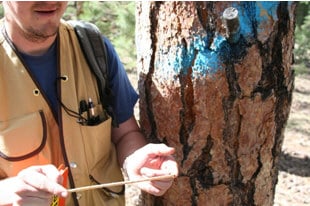
Note from Sharon.. I wasn’t around to post this earlier today. To restate what I’ve said before,
it’s not what used to happen that matters (vegetation fire histories). It can’t matter if climate change is really “unprecedented” as per climate scientists. Assuming that they are correct, we can’t go back- we need to move forward carefully and respectfully of the people and the land.
That’s why I think fire ecologists can debate what used to happen till the cows come home (or their permits have been bought out by conservation organizations;)) but we should be more concerned about managing for the future. Vegetation ecologists think that past vegetation ecology should drive the future (after careful study of past vegetation ecology). Other people might frame the question differently.
Should we, in the interior west, manage tree vegetation outside the WUI for defensible space?
Framed that way, many more disciplines might have something to say. Plus of course “should” is a normative (value), and not a science (empirical) question.
Academic tiff over wildfires rekindled
CYNDY COLE Sun Staff Reporter | Posted: Tuesday, February 21, 2012 6:00 am | (0) Comments
An academic tiff over whether catastrophic wildfires can be prevented has broken out anew just as a broad-based northern Arizona coalition is getting set to try to do just that.
Two researchers at the University of Wyoming contend that stand-replacing crown fires on the order of 2002’s Rodeo-Chediski fire and last year’s Wallow fire were once the norm on the Mogollon Rim.
“It’s probably not going to be the case that you can prevent these high-severity fires,” said Bill Baker, a researcher in ecology and geography there.
Local researchers wasted no time in terming the paper “fringe” research far outside the mainstream.
“The overwhelming evidence from decades of research by scores of scientists is that ponderosa pine forests over evolutionary time have been shaped by frequent, low-intensity fires, not stand-replacing fires,” wrote Wally Covington, director of Ecological Restoration Institute at Northern Arizona University, in an e-mail. “Further, fires on the scale of the Rodeo-Chediski and the Wallow Fire are an unprecedented threat not only to plant and animal communities, but also to watershed stability and to the human communities that depend on frequent fire forests for natural resource values and jobs.”
BIG PUSH TO THIN
Covington and other local researchers contend that wildfires are bigger than normal now, and it’s due to unhealthy forests that have grown abnormally dense because of factors like fire suppression, logging and grazing.
The University of Wyoming researchers find otherwise, saying that thick forests and big fires are a norm here.
This is significant because the Coconino, Kaibab, Apache-Sitgreaves and Tonto national forests are now on the brink of a major push — the largest in the country — to get commercial outfits to thin about 30,000 acres per year of smaller-diameter trees as a proposal to make the forest healthier.
A decade-long contract will likely be granted in a few months with support of loggers and conservationists to begin some of this work near Flagstaff and Williams.
EVIDENCE FOR THINNING INCOMPLETE
Baker and a second researcher used data from early surveyors working in the 1880s to determine that the forest here, along the Mogollon Rim, was once a mix of wide-open parks and about two-thirds dense stands of trees.
“They actually have a little booklet that they carried with them. And they wrote as they walked along the lines … they described how dense the forests were, and they recorded information at the corners about the trees that were there,” Baker said.
The researchers appear to oppose some of the planned forest thinning.
“These efforts are expensive and have some negative ecological impacts, and evidence to support them is spatially and temporally incomplete,” Baker and researcher Mark Williams wrote in their research. “…Common management practices today include extensive, rather uniform reduction in tree density, removal of understory shrubs and small trees, and other fuel modifications to lower fire severity. Our reconstructions show that these common practices, if widespread, will move most dry forests outside their historical range of variability, rather than restore them, probably with negative consequences for biological diversity.”
APPLES VS. ORANGES
But Pete Fule, a professor and expert in fire ecology at Northern Arizona University, said the research out of Wyoming could be problematic because it groups together forests that have different fire regimes and is “not consistent with the findings of literally hundreds of other researchers.”
What used to be considered a “severe” fire is measured much differently today, he said, so to compare the two is to weigh apples against oranges.
“It is almost certainly not a straight comparison,” Fule said.
Added Covington:
“The weight of the scientific evidence coupled with the current outlook for increasingly severe fire seasons are a call to action. These facts coupled with the historic increases in size and severity of crown-fires throughout the West, but especially in Arizona and New Mexico, point to the need for redoubling our efforts to restore landscapes on the scale of the Four Forest Restoration Initiative. We have already wasted too much time with bickering over fringe ideas,” he wrote.
Cyndy Cole can be reached at 913-8607 or at [email protected].
Read more: http://azdailysun.com/news/local/state-and-regional/academic-tiff-over-wildfires-rekindled/article_56b19873-4dfc-530c-a3d8-a99844c6d290.html#ixzz1nGxQVYwR

